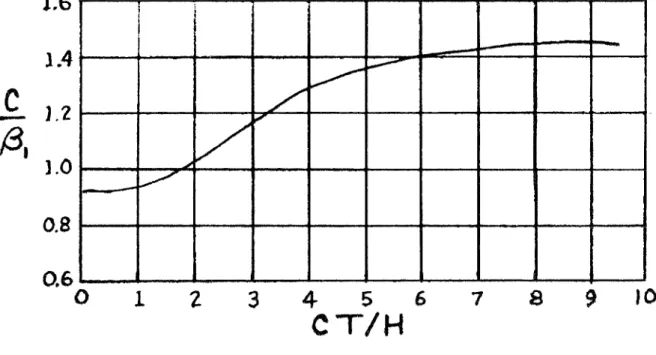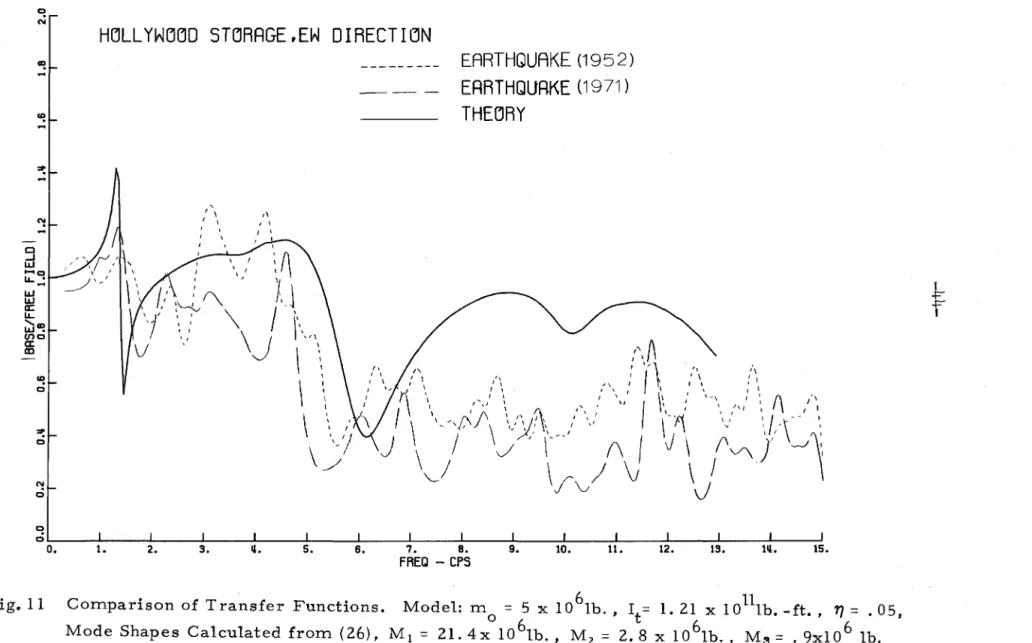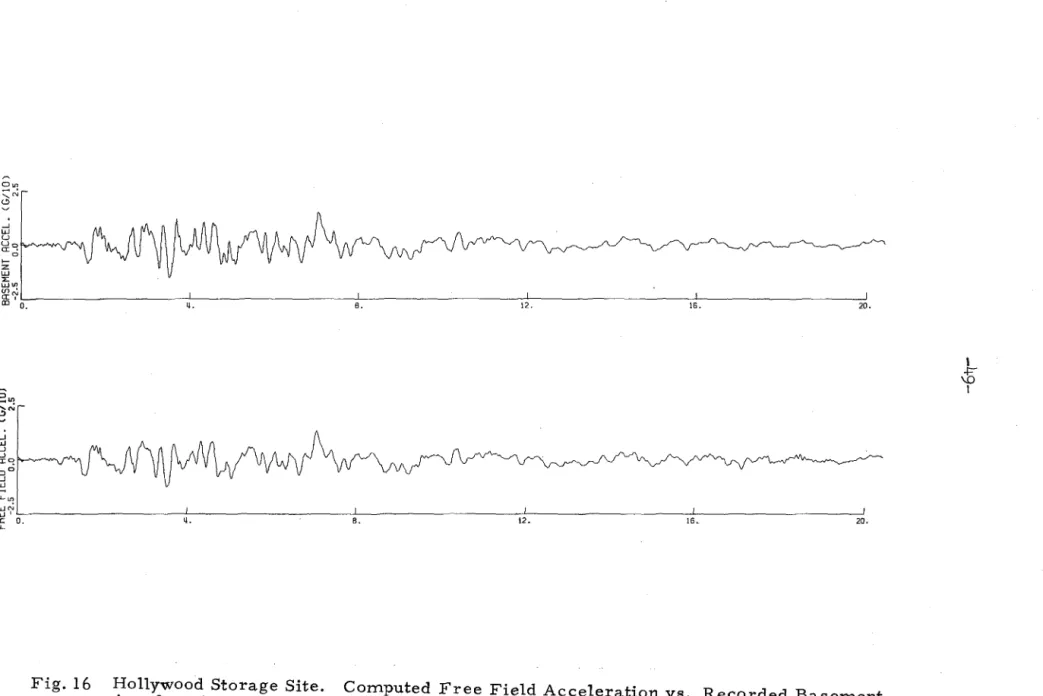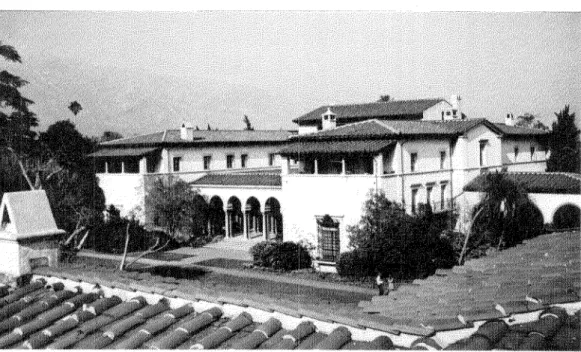Evidence of soil-structure interaction in the basic EW condition of the Hollywood Storage building is seen in the earthquake data. The Millikan Library and Athenaeum are on the campus of the California Institute of Technology. The frequency-dependent base shift distorts the transfer function near the natural frequencies of the superstructure (Fig. 5).
The addition of the overturning moment, ~' and the rocking flexibility have a negligible effect on the transfer function for. Duke's approach assumed that the acceleration from the parking lot was representative of free field motion. The accelerograph in the basement of the building is located in the southwest corner and is also standard.
The calculation of the parameters needed for the theoretical model was based on the data collected by Duke (26), (27). A brief discussion of the modeling of each building-soil structure follows the analysis of the results. For example, in the case of the Hollywood Storage building in the EW direction, L ~ 200 ft.
In the analysis of the Hollywood Storage building, their presence was due only to the increase in the mass of the foundation.

MILLIKAN LIBRARY N-S OIRECTICN
RATIO OF FOURIER AMPLITUDE SPECTRA. BASE MOTION/FREE FIELD MOTION
FR6QUENCY HZ
EARTHQUAKE (1952)
EARTHQUAKE (1971)
HLJLLYWLJLJD 5TLJRRGE.EW DIRECTILJN
THELJRY
EARTHQUAKE (1952) EARTHQUAKE (1971)
D D GRAOUATE 140USE$
RTHENREUM MILLIKAN
ATHENAEUM MILLIKAN
RRTIO OF BRSEMENT RESPONSES.EW DIRECTION
RATIO OF BASEMENT RESPONSES.NS DIRECTION
THEORY ___ EARTHQUAKE
EARTHQUAKE
1ncom1ng
In addition to quantitatively describing the frequency content of a given acceleration gram, the modulus and phase of the Fourier transform have a. The total depth of the layers is the distance between the rock and the foundation. A comparison of the results of the analysis and the data shows that no differences in the recorded accelerations can be attributed.
31 shows the location of the selected buildings, 2 to 3 miles from the clustered group in the Wilshire-Norma.ndie district. For the vertical and EW directions, the dispersion in the Wilshire-Normandie spectra is contained within the spectral limits of the surrounding buildings. The spread of the higher frequency content from north to south is most evident in the vertical accelerograms.
However, there was no absolute correlation between g peak and F.A.S amplitude levels.
LAY FR PARAMETERS
DENSITY EST. SHEAR VEL
WILSHIRE
3470 WILSHIRE
TIME - SEC
TJME - SEC
STUDIES OF WAVE SUPERPOSITION AND INTERPRETATION OF DIFFERENCES IN THE ACCEIEROGRAMS
These studies show that the effects of surface topography become important for seismic wavelengths comparable to the characteristic dimension of the surface irregularity. In the previous chapter, it was found that some of the larger differences in m.s accelerations were related to the distance from the epicenter. Solutions of the frequency equation were obtained for specific choices of the parameters involved.
For a two-layer system, the phase velocity cannot exceed the shear wave velocity of the second layer or substrate (58). For the dispersion to account for acceleration differences from the Wilshire-Normandie group, a significant portion of the San Fernando earthquake energy must have been in the form of surface waves. Unfortunately, it appears that P (dilithal), S (shear), and surface waves cannot be clearly identified with any degree of confidence in the strongly shaking parts of the accelerations that exhibit higher frequency accelerations.
The local geology must be known to a depth of the order of half the wavelengths of surface waves (58) before any approximate model for dispersion can be formulated. Some numerical examples illustrate to some extent some of the basic differences observed in Wilshire-Normandie accelerations. This relative time lag is a function of the distance between the stations and the apparent speed of the wave pulses.
If some of the differences in the Wilshire-Normandie Accelerogra.m.s can be attributed to surface wave dispersion, more information is needed before any definitive statement can be made. Even if this model showed that large differences in accelerations could be expected, the question still remained of how much of the surface wave energy comprised the hard shaking of the acceleration parts. This issue does not seem to be resolved based on accelerogra.ms review alone.
The acceleration data from the Wilshire-Normandy area do not indicate that the shapes of the earthquake waves have been significantly changed within this area. Therefore, it seems possible that large differences in acceleration.ms may be due to differences in the arrival times of the waves due to differences in travel paths and speeds. However, comparisons made in the previous chapter between accelerograms 2 to 6 miles apart definitely indicate that the shape of the waves has been significantly altered.

TIME-SEC
FREQ - CPS
GENERAL CONCLUSIONS
The local effects at the locations studied in this report were not thought to be the main sources of differences observed in the accelerations of the San Fernando earthquake. Although there was evidence of soil-structure interaction from the fundamental mode of Hollywood Storage construction: one-way, the theoretical. Thus, proposed changes to the design spectra reflecting differences in subsurface conditions from the type that exists at this site should be seriously questioned, based on the ground motions during the San Fernando earthquake.
Differences in the motion paths of incoming waves, along with differences in wave speeds, can substantially alter ground motion at two locations that are fairly close to each other. This phenomenon can be predicted theoretically without the assumption that the shape of the waves changes as they travel between locations. For locations in the same direction from the center of the earthquake but at different distances, differences in the intensity of the hard shaking could be easily recognized over distances from location to location of only 3 miles at an average distance of 34 kilometers from the center of The earthquake. earthquake.
To obtain a better understanding of the soil-structure interaction phenomenon and the nature of the ground motion at a given location during an earthquake, a thorough array of accelerographs is necessary. For example, on the campus of the Cali:rornia Institute of Technology, more accelerographs to measure actual ground motion in addition to the accelerographs already located in the basements of the Millikan Library and Athenaeurn would be helpful in solving these problems during future earthquakes. The critical damping ratio for the rigid base structure's j. mode is defined by .
Reissner, E., 11Stational axialsimmetricsche durch eine schutelnde Masse erregte Schwingungen eines homogeneu elastichen Halbraumes, 11. B., "Forced Vi-brations of a Body on an Infinite Elastic Solid, 11 Journal of APJ?lied Mechanics, Vol. N., “Forced vibration of a rigid circular plate on a semi-infinite elastic space and on an elastic layer, 11 Philos. B., '1Forced Vibration of a Body on an Elastic Stratum, n Journal of Applied Mechanics, Vol. and Found Div., ASCE, Vol. E., 11Dynamic Response of Footings to Vertical Loading, 11 Journ. Kobori, T., Minai, R., Suzuki, T., Kusak.abe, K., 11Dynamical Ground Compliance of Rectangular Foundations," Proceedings of Sixteenth Japan National Congress for Applied Mechanics, 1966. and*obori, T., 11Dynamical Compliance of Rectangular Foundations on an Elastic Half-Space, 11 Journal of Applied Mechani'cs, Vol. A., "Soil Structure Interaction in Earthquake Resistant Design," Research Report R70-59, Dept. D., "Surface Motion" of A semi-cylindrical alluvial valley for incident plane SH waves, 11 Bull.
Bielak, J., "Earthquake Response of Building-Foundation Systems,11 Ph.D. H., "Analysis of the Earthquake Response of a Nine-Story Steel-Frame Building During the San Fernando Earthquake," Journal of Applied Mechanics, ASME, Vol. L., 11 Tangential and Torsionally Forced Vibrations of a Rigid Circular Disc in a Semi-Infinite Solid. J., "Site Characteristics of the Southern California Strong-Motion Earthquake Stations, Los Angeles Dept. 11, Report No . M., "Soil Moduli and Damping Factors for Dynamic Response Analysis", Univ. editor), Earthquake Investigations in the Western United States, USA
![Fig. 3 Values of 1I13 and ; for (] = 1I4.](https://thumb-ap.123doks.com/thumbv2/123dok/10401930.0/41.921.85.724.122.1076/fig-3-values-1i13-1i4.webp)







